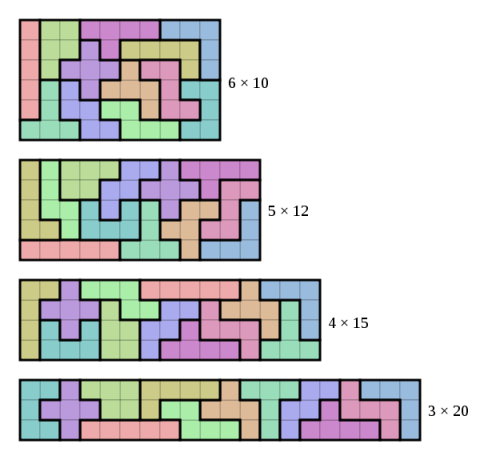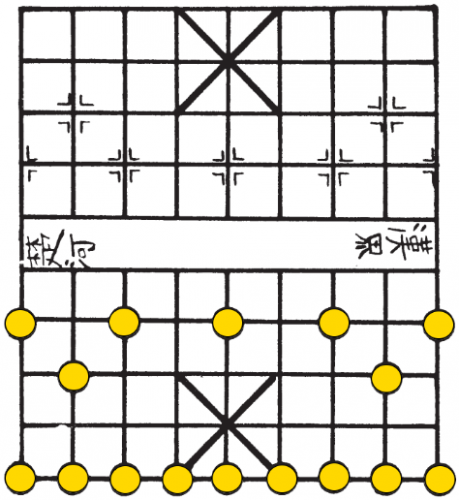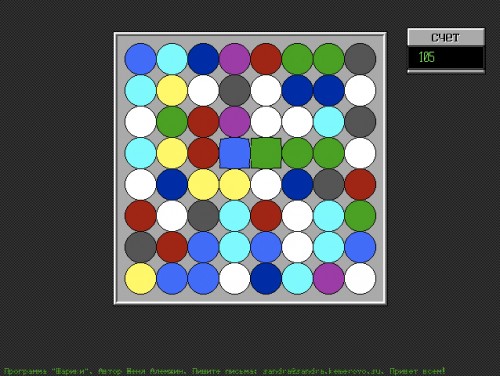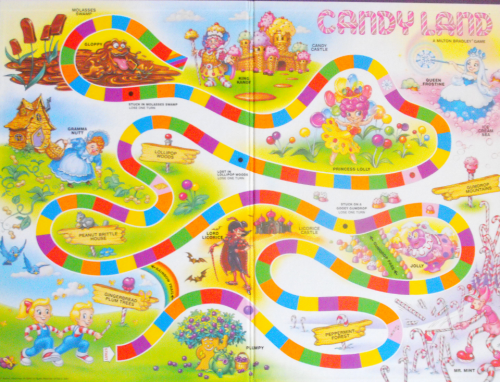Old, very old, super old: in search of inspiring ideas for successful games
What games could inspire the authors of Clash Royale and Candy Crush Saga, – Plarium game designer Vadim Loktionov told in his blog on Gamasutra. For App2Top.ru he offered a Russian version of the material.

Sources of inspiration for classic games
There are many projects on the game market today. There are some very successful ones among them, whose gameplay is so exciting that it involves players for many months and even years, for example, Snake, Pac-Man and Tetris.
These games are considered original, but their authors also drew ideas from other projects. One of the most confusing stories is Snake.
In 1975, game designer Mirko Marchesi created a board game for two players called Blockade. To win the game, it was necessary for one of the player’s chips to occupy the original location of the opponent’s chips.
The Blockade Box
Each turn, players could place one chip at a distance of one or two empty squares, as well as place one obstacle wall, the purpose of which was to hinder the movement of the opponent’s chips. After the players run out of walls, they continue to move the chips until one of the players wins.
Rules of the Desktop Blockchain
A year later, in October 1976, an arcade video game for two players with the same name, Blockade, was released. The game was developed by designers Lane Hauck, Ego Kiss and Bob Pecarero. It was published by Gremlin Industries.
The video game Blockade
Each player moved his character along the plane, leaving a solid line behind him. All movements were carried out on the field using an invisible grid, so players could only make turns in motion at an angle of 90 degrees. The winner was the player who stayed on the field longer compared to his opponent (the first one who hit obstacles on the field lost).
Blockade Slot Machine
It is believed that the Snake mobile game was based on the concept of the Blockade game in the 1976 arcade version. The most significant difference of the Finnish game was that the game was designed for one player.
The story of Pac-Man, published in 1980 “from the pen” of Toru Iwatani, is much simpler.
In the late 70s – early 80s, most popular games were based on Space Invaders. Accordingly, they were all designed mainly for one, far from the widest audience.
Space Invaders
“There was not a single game that everyone liked at the same time, and especially games for women. I wanted to create a fun game that would appeal to women,” Thor then stated in an interview.
The idea of the game came to the creator from the kaji (Chinese characters used in Japanese writing) word taberu, which means “to eat”. This little word became the cornerstone for the idea of a future game.
Taberu
The history of another cult game – “Tetris” – is widely known in Russia. In 1984, it was developed by the Moscow programmer Alexey Pajitnov.
Pajitnov studied the problems of artificial intelligence and speech recognition, and used puzzles to test ideas – including the classic pentamino.
A pentamino is a flat geometric figure consisting of five identical squares connected by sides. The idea of pentamino was developed by American Professor Solomon W. Golomb in 1953.
These rectangles can be assembled from various pentaminos
In his work, Pajitnov tried to automate the laying of pentamino into given shapes. However, then the computing power of the equipment for rotating pentamino was not enough, we had to debug on tetramino, which determined the name of the game. In these experiments, the idea of the future Tetris game was born.
What is the main reason for the success of the game idea?
One of the main factors of the success of the game title is the originality / exclusivity / uniqueness of the idea of the game itself.
But how is the birth of that very idea and the choice of the most successful of dozens and hundreds of others? Why do only some of the ideas become the basis for a future game project?
Thinking can be considered as the process of creating, developing and transmitting ideas, where the idea is understood as the main element of thought, which is visualized in a concrete or abstract form (Ben Jonson – Design Ideation: the conceptual sketch in the digital age).
There are many ways to find new ideas for the game, among others:
- observing the world around you;
- prototyping;
- thought process (rational, irrational thinking or a combination of them);
- play games of all genres;
- participation in an unfamiliar type of activity;
- mind mapping;
- the thinking hat method;
- the method of associative thinking;
- experimentation;
- creative retrospective.
I would like to elaborate on the use of the creative retrospective method to create new ideas or their components as the basis of a future game, because, as we managed to see a little above, successful ideas of the past are a good tool for inspiration, because they are confirmed by many years of experience of using a large number of people.
A brilliant idea for a midcore game
One of the most popular games of the beginning of 2016 was the Clash Royale game. This game contains the best game mechanics from collectible card games to MOBA, the title is the brightest representative of addictive games.
I would like to consider one of the mechanics of the game, namely the playing field in the form of a battle arena with two defensive towers on the flanks. Let’s make an assumption where the idea of such game mechanics could have come from.
One of the representatives of tabletop war games is the Xiangqi game, which is also called Chinese chess. Unlike classical chess in Chinese chess, each army has a central fortress in which a general sits. To win the game, it is necessary to take the enemy’s fortress by storm. A river flows between the two armies, which heavily loaded elephants cannot overcome, other light figures freely force it.
Xiangqi
A Chinese chess board with the pieces of one of the players in the starting position.
The goal of the game is to checkmate/pat the enemy general.
What if we compare the Clash Royale field and the Chinese chess field?
Xiangqi and Clash Royale
Obviously, in Chinese chess, as in Clash Royale, a similar goal for victory is to defeat the tower of the king/general.
Sweet idea of a three-in-a-row game
Three-in-a-row games (match 3) can be called another contender for top positions not only in mobile stores, but also on social platforms. Over the past sixteen years, this genre has not only not lost its popularity, but on the contrary, has become one of the most popular game genres.
Many articles have been written about both the history and the genre itself, among which I want to mention Swap Adjacent Gems to Make Sets of Three, Match Game Mechanics: An exhaustive survey, Match 3, From Bejeweled to Candy Crush: Finding the key to match-3, but there is no consensus where the idea of the genre came from, No.
The earliest mention of the use of such game mechanics in video games refers to Shariki. This is a puzzle game developed by Evgeny Alemzhin in 1994 under the DOS system.
Balloons
Jesper Juul in the article Swap Adjacent Gems to Make Sets of Three writes about the possibility of the origin of the genre from the idea of a board game Mancala (1894).
I, in turn, assume that the genre may have alternative origins. In my opinion, it could be a Three Men’s Morris board game where the game board consists of nine dots. Each player has four chips of “his” color. The players take turns placing one chip per point. If one player manages to place three of his chips on the same line, then he wins. The first mention of games with a similar idea occurs in 1400-1300 BC.
In general, any game of the past with the basic mechanics of moving objects could give rise to the Match 3 game genre.
In April 2012, the well-known game title Candy Crush Saga brought a new experience to the Match 3 genre not only by adding new mechanics on the playing field and new approaches to the design of game levels, but also by introducing such an innovation as a global game map using the mechanics of social interaction of players on it.
Map in Candy Crush Saga
The global game map displayed the player’s overall game progress, gave the opportunity to compete and interact with friends. The global map itself was divided into several episodes, which were connected by the narrative history of the game world, which, in turn, motivated the passage.
I was wondering where the idea of such game mechanics could come from.
The Candy Land board game was developed in 1948 by game designer Eleanor Abbott.
Candy Land
According to the storyline of the game, players had to move along the global map and find the Candy King at the end of the way. The first one who reached the Candy Castle won the game.
Comparing these games, I’m not talking about the similarity of the game setting, but I’m talking about the possibility of combining aspects such as competition, interaction with friends and storytelling in one game mechanics of the global map used in both games.
Qui quaerit, reperit (He who seeks, finds – lat.)
It seems to me that finding the right idea for games is a difficult, but no less interesting process. By studying the experience of the games of the past, we are able to find something valuable for the ideas of the games of the present.
Some people think, “There are no new ideas, they are just a combination of old ones.”
Do you agree with this statement?











